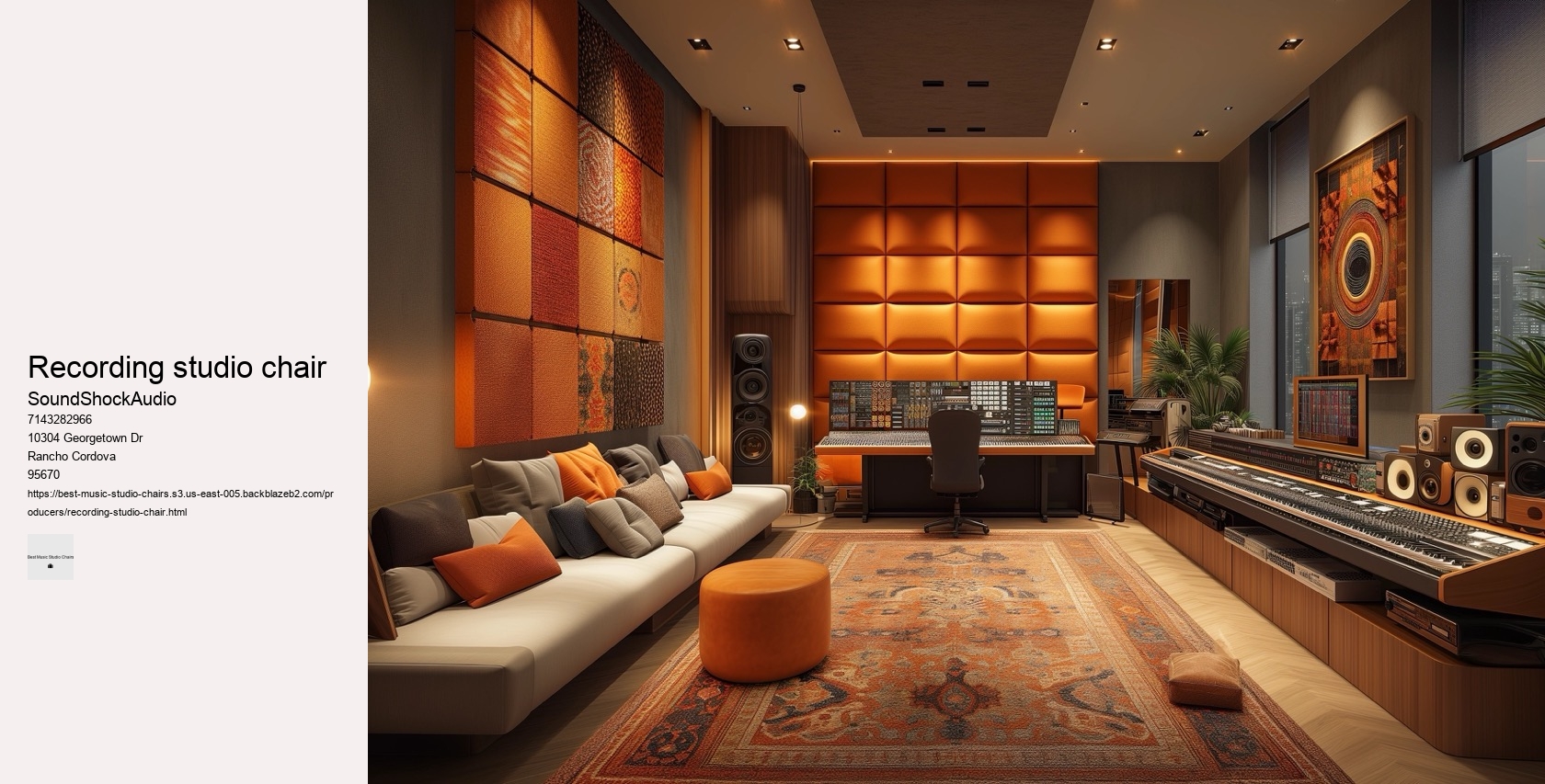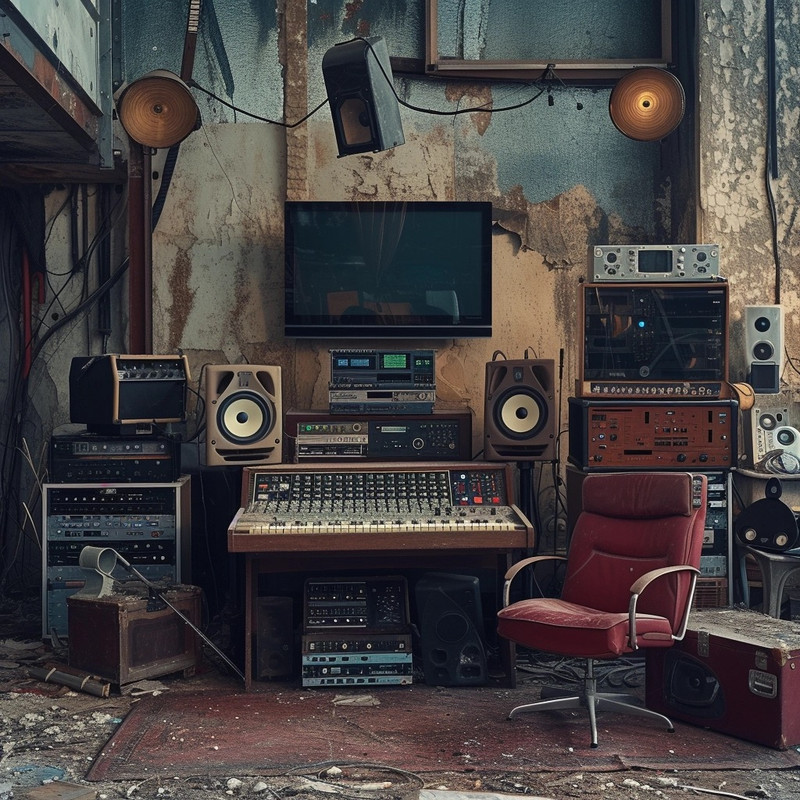

Choose a chair with adjustable features—think lumbar support that defies gravity or armrests that refuse conformity—allowing you to orchestrate your ideal sitting posture. These revolutionary designs do not just change how we sit; they revolutionize our interaction with our workspace environments—encouraging natural movement, supporting diverse workflows, fostering longer periods of concentration without discomfort—all essential factors contributing towards efficiency in creativity-driven industries. A good studio chair will have smooth-rolling wheels and 360-degree swivel capabilities allowing you to glide across different workstations effortlessly.
This will create a quirky and unusual text that maintains the essence of the topic but with a twist.---When we delve into the realm of studio furniture, particularly chairs designed for music producers, durability stands as a paramount attribute. Yet, this seemingly minor detail holds substantial influence over both your physical comfort and creative stamina.
Take Regular Breaks: Stand up and stretch every 30 minutes to keep muscles loose and blood circulating.3.
Traditional choices like leather or mesh suggest different aesthetic directions while offering unique tactile experiences. Firstly, consider the nature of movement — or rather, the lack thereof. Yet delve deeper into its design elements, and you'll find that each curve, texture, and material choice speaks volumes about the ethos it carries. However, comfort extends beyond just physical well-being; it encompasses the mental state as well. Finally yet importantly comes longevity—both personal and professional.
Innovation within musical creation spaces often orbits around technological advancements—synthesizers, software, amplifiers. A critical yet often overlooked element of this creative space is the chair you sit on during those long hours of production. The backbone of any good studio chair is its lumbar support. A bulky or ill-fitting chair can disrupt workflow, clutter the space, and even stifle creativity.
Educational initiatives about proper seating ergonomics should be commonplace in offices as well as other settings where people tend to sit for extended durations. Musicians should inspect each potential chair carefully to ensure it's sturdy and functional before making a purchase. Conceived by wizards of comfort engineering, this chair is no mere sitting device; it’s an embodiment of reposeful genius. These adjustments allow you to maintain a healthy posture, reducing strain on your back, neck, and shoulders.
Each cushion whispers secrets of cloud-like serenity to weary backs bent over mixing consoles. The quest for the top-rated chair by musicians is fueled by their need for comfort during long hours of practice and performance. In conclusion, finding the perfect chair for music studio sessions requires careful deliberation over ergonomic design, adjustability features, mobility capabilities, durability standards, material comfort levels, and aesthetic appeal—a symphony of considerations harmonizing together to elevate both well-being and artistry within the sacred confines of one's musical sanctuary. Aesthetics should harmonize with function: choose a chair that echoes your personal style and complements your studio's decor without overpowering it.
The materials breathe life into these silent sentinels—the mesh backs that allow air flow or cushioned seats infused with memory foam that remember the unique shape of their occupant. Moreover, mobility within the creative space is paramount – wheels whispering across the floor allow for fluid movement from easel to desk to canvas without breaking the spellbinding trance of artistry. For artists, writers, designers, or any individual deeply engrossed in the creative process, an ideal studio chair serves as a steadfast companion through hours of introspection and imagination. The tilt tension control allows users to recline comfortably while maintaining control over their seating angle – an important factor when trying to find an optimal balance between relaxation and concentration during various tasks throughout the day.
Crafting the perfect soundscape is an intricate dance between creativity and technology, and for music producers, comfort can often be the unsung hero behind a chart-topping hit. Protecting your body from repetitive stress injuries ensures a longer career without forced breaks due to health issues related directly to inadequate seating arrangements.


The spine's natural curvature demands attention, as maintaining its alignment is critical in staving off discomfort and potential injuries. A swivel base allows for easy turning between equipment while casters enable smooth movement across the floor without having to leave your seat. A striking example is the incorporation of motion technology allowing seats to subtly move with the user, preventing static pressure points and promoting circulation. Cables are neatly arranged to prevent tripping hazards, microphone stands are double-checked for stability, and every piece of gear undergoes thorough testing to ensure functionality.
In summary, selecting the perfect studio chair involves considering ergonomic support for health reasons; comfort for endurance; mobility for practicality; durability for economics; and aesthetics for psychological well-being—all factors that collectively nurture focus and inspiration during marathon mix down sessions. The throne for any serious producer isn't just about physical ease—it must also inspire confidence and enhance focus. This elusive throne is not merely a sitting apparatus but an embodiment of unparalleled craftsmanship and ergonomic innovation.
Top producers often find themselves glued to their workstations for extended periods, diving deep into the intricacies of mixing and mastering. Color choices further influence perception; bold hues might inspire energy and creativity whereas muted tones could foster concentration and calmness. Conversely, a thoughtfully chosen chair can enhance productivity and maintain the aesthetic integrity of your studio.
It would provide incomparable support to the spine with a backrest that contours naturally to the body's curvature, ensuring those marathon mixing sessions don't take a toll on physical wellbeing. Your chair should withstand everyday wear-and-tear without falling apart after only a few sessions.
However, incorporating this functionality without compromising on style requires an innovative approach—melding practicality with elegance. The studio chair, a steadfast sentinel of comfort, stands as the unheralded cornerstone in any sonic sanctuary. In conclusion, discerning producers must prioritize durability and build quality when selecting their central work tool—their chair—to foster an environment where creativity can flourish unimpeded by concerns over equipment reliability or comfort degradation over time.
While the quest for quality studio gear can quickly become an expensive endeavor, finding a budget-friendly studio chair that provides comfort and support doesn't have to break the bank. They achieve this through several mechanisms such as self-adjusting lumbar supports, articulated backrests, and responsive seat pans.
When discomfort is absent from our seating experience, we can immerse ourselves fully in creative tasks without distraction — an invaluable benefit for anyone dedicated to their craft. Creating an essay that intentionally selects the least probable word every six words would result in a nonsensical and disjointed text.
Its silhouette whispers sophistication while its build promises enduring reliability. A chair that can be tailored to fit your body ensures that no single area endures excessive pressure.

Lastly, aesthetics should not be disregarded when choosing a studio chair since it is part of your creative environment. Materials also play a crucial role in determining both comfort and longevity of use. Whether for painter's caverns, minstrel nests or weaver’s lairs, every stool must juggle twin enchantments."
Resourceful musicians could revamp an existing chair by adding cushions or making other modifications to enhance its comfort level without spending much money. Lastly but importantly is sustainability; opting for chairs made from recycled materials or from companies committed to eco-friendly practices reflects an awareness beyond one's immediate surroundings—an ethos often inherent within the artistic community.
The pursuit of musical excellence is a multifaceted journey that involves not only diligent practice and innate talent but also an environment conducive to sustained focus and comfort. Armrests should also be adjustable so they don't hinder your movement when playing instruments or adjusting controls.
Your workspace should inspire you; if vintage vibes spark your creativity opt for retro-inspired designs; if modern minimalism fuels you go for sleek lines and neutral colors. Leather may exude luxury and status, but it can also trap heat—leading to discomfort during extended periods of use.
Choosing between budget-friendly and high-end options depends on multiple factors like financial constraints, duration of use per day, and personal priorities regarding health and comfort. While such chairs command a premium price tag, they represent an investment in one's health and efficiency. Setting aside time for short breaks where you stand up, stretch out or walk around is crucial for maintaining back health over longer stretches of time. Thus concludes our capricious cataloging of esteemed studio chairs—champions chosen not through frivolous fancy but rigorous rendezvous between artist and instrument; where each note played is nurtured by unseen sentries made tangible only through absence when melody falters upon their departure—a testament to their silent symphony conducted below radar yet resonating beyond audible spectrums. Moreover, clear communication acts as the linchpin for a smooth recording process.
The first enigmatic contender is a chair draped in moonlight velvet—a peculiar choice for studios drenched in shadow and sound waves. Mesh designs are lightweight and less visually imposing than solid forms—important factors in making a small studio appear larger than it is. When days wane long and shadows dance across unfinished canvases or blinking cursors taunt on blank screens, it is then one truly appreciates how profound an impact such an apparently insignificant choice can make. Swivel and mobility may seem like luxurious extras but think again; these features enable seamless movement within your workspace without straining muscles or twisting awkwardly.
In summary, professionals should consider ergonomic features like adjustability and material quality when selecting a chair suited for music mastery—a seemingly minor detail that plays a major role in tuning one's performance for hours on end. The right chair can be pivotal in sustaining healthful practices while fostering an environment conducive to creative success—an investment worth making for any dedicated music professional looking to deliver their best work comfortably session after session. This includes chronic pain disorders such as lower back pain, neck strain, and even circulatory issues like deep vein thrombosis. Leather chairs can symbolize opera’s grandiosity but might not breathe well during extended sessions.
As creators and artisans of the digital world, we often overlook the profound impact that our physical workspace can have on our productivity. Creating a comfortable and ergonomic workspace is crucial for up-and-coming musicians who spend countless hours practicing and recording. The material of the chair also plays into space efficiency. By integrating these strategies into your daily routine alongside using an ergonomic chair, you create an environment conducive to sustained productivity without succumbing to exhaustion's grip.
Artists often use adjustable and ergonomic chairs to support long hours of work in their studios. These chairs are designed to provide comfort and flexibility, allowing artists to adjust the height and tilt to maintain good posture while working. Drafting chairs, which are taller with a foot ring, are also popular among artists who work at drafting tables or easels.
The best chair for content creators is one that combines ergonomic design with functionality to support long hours of work. Chairs like the Herman Miller Aeron or the Steelcase Gesture are highly recommended due to their adjustability, support, and comfort. These chairs help in maintaining good posture and reducing strain, which is crucial for content creators who spend extensive periods sitting.
The frequency at which you should get a new computer chair depends on several factors including the quality of the chair, how much use it gets, and whether it still provides proper support and comfort. Generally, a good rule of thumb is to consider replacing your computer chair every 5 to 10 years. However, if you notice any signs of wear and tear, such as sagging, squeaking, or diminished comfort, it might be time to get a new one sooner.